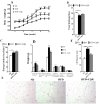Combination treatment with quercetin and resveratrol attenuates high fat diet-induced obesity and associated inflammation in rats via the AMPKα1/SIRT1 signaling pathway
- PMID: 29285143
- PMCID: PMC5740593
- DOI: 10.3892/etm.2017.5331
Combination treatment with quercetin and resveratrol attenuates high fat diet-induced obesity and associated inflammation in rats via the AMPKα1/SIRT1 signaling pathway
Abstract
Diet-induced obesity is associated with systemic inflammation, which is considered to originate predominantly from the adipose tissue. Quercetin and resveratrol are two dietary polyphenols that exhibit anti-inflammatory properties and anti-insulin resistance when administered in isolation or combination (CQR). It remains unknown whether CQR reduces high fat diet (HFD)-induced obesity and inflammation in rats. In the current study, 46 male Wistar rats were divided into two groups, one of which was fed a normal diet (ND, 5.4% fat, w/w) and one of which was fed a HFD (45% fat, w/w) for 3 weeks. Following removal of the 12 most obesity-resistant rats from the HFD group, the remaining rats were divided into two sub-groups: A HFD group and a HFD+CQR group (administered 120 mg/kg/day resveratrol and 240 mg/kg/day quercetin). The results revealed that the HFD+CQR group had significantly lower body weights at 11 weeks compared with the HFD group and had significantly reduced visceral adipose tissue weights and adipocyte sizes. Serum lipid profiles were also significantly ameliorated in the HFD+CQR group. CQR attenuated the expression of systemic proinflammatory adipokines, including leptin, tumor necrosis factor-α, monocyte chemoattractant protein-1 and interleukin-6. It also reduced the recruitment of mast cells to the epididyotic adipose tissue (EAT). Furthermore, CQR reversed the HFD-induced suppression of 5'-adenosine monophosphate-activated protein kinase α1 (AMPKα1) phosphorylation and sirtuin 1 (SIRT1) expression in EAT. In conclusion, CQR may suppress obesity and associated inflammation via the AMPKα1/SIRT1 signaling pathway in rats fed a HFD.
Keywords: 5′-adenosine monophosphate-activated protein kinase catalytic subunit α-1; high-fat diet; inflammation; quercetin; resveratrol; sirtuin 1.
Figures



References
-
- van der Heijden RA, Sheedfar F, Morrison MC, Hommelberg PP, Kor D, Kloosterhuis NJ, Gruben N, Youssef SA, de Bruin A, Hofker MH, et al. High-fat diet induced obesity primes inflammation in adipose tissue prior to liver in C57BL/6j mice. Aging (Albany NY) 2015;7:256–268. doi: 10.18632/aging.100738. - DOI - PMC - PubMed
-
- Ronti T, Lupattelli G, Mannarino E. The endocrine function of adipose tissue: An update. Clin Endocrinol (Oxf) 2006;64:355–365. - PubMed
LinkOut - more resources
Full Text Sources
Other Literature Sources
Research Materials
